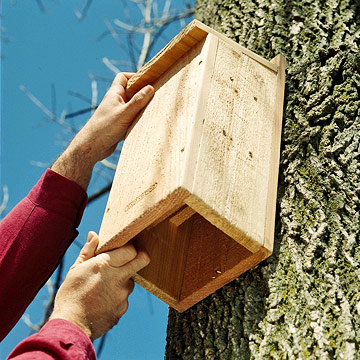





Bats are the most misunderstood of our garden residents. Do these critters send a chill down your spine? If so, read on. Bats have an undeserved reputation for being bloodsucking, disease-carrying, dirty little rodents. Don't let these myths about bats scare you -- embrace them (not literally, of course) and attract them to your garden!
continue reading belowThese little flying mammals are great hunters of mosquitoes and other annoying insects. In fact, research reveals that a single bat can eat more than 600 mosquitoes per hour. They're a fantastic, organic pest-control method.
By creating a bat-friendly yard, you're also doing good on a grander scale. Like many species, bat populations are declining due to pesticide use and habitat loss.
Click here to learn how to conquer animals that are true pests in the garden.
Like birds, bats prefer a source of shelter and they'll often hang out in old trees and large shrubs. Bats nest in abandoned buildings, hollow trees, under a building's eves, in loose tree bark, and in bat houses. Bats also enjoy water features, such as ponds, where insects may congregate.
Planting night-blooming flowers will help attract bats (and give your yard another level of beauty). Some great night-bloomers include datura, moonflower, four-o'clock, yucca, evening primrose, night-blooming water lily, night-blooming jessamine, cleome, and nicotiana.
Enjoy a Moon Garden
More Tips to Attract Wildlife
Like any mammal, bats can catch rabies. But they're not as likely to catch the disease as many other animals -- and even if they do, you're less likely to come into contact with them. (That said, never handle a bat or any other wild animal in your yard.)
According to the Organization for Bat Conservation, bats are not inclined to chew holes in your home's attic. However, they will find openings and nest in attics if they can.
And no, bats won't suck your blood. Most North American species prefer to dine on insect pests (such as bloodsucking mosquitoes). A few bat species are even important pollinators and feed off the pollen and nectar of flowers.

Bat houses are a great way to provide habitat for bats. Use a rough, nontoxic wood (such as plywood or cedar) to make your box. The rough surface will make it easier for bats to climb in and out of the house. Keep the roughest side of the wood to the inside of the house.
Bat houses work best if they're at least 2 feet tall, 1 foot wide, and 3 inches deep. Hang them 10 to 15 feet above the ground and place them in a sunny spot where they can absorb lots of heat during the day. (Painting the boxes black is helpful.) Mount bat houses on poles, buildings, or other structures.
Copyright © www.100flowers.win Botanic Garden All Rights Reserved